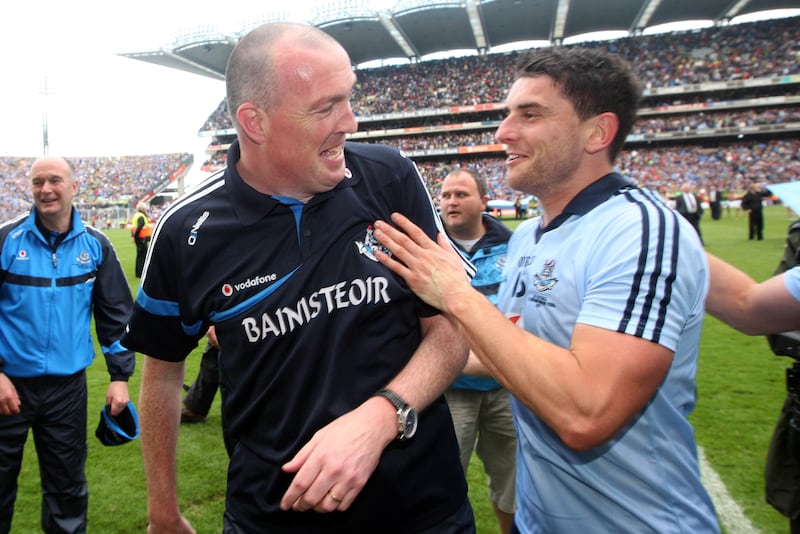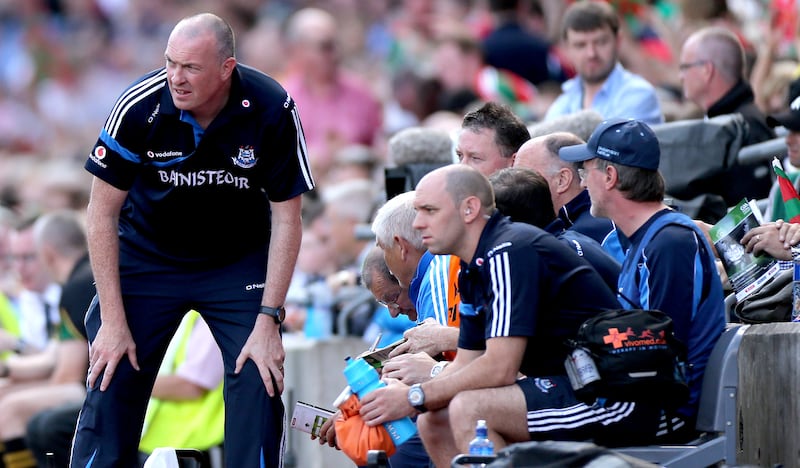Dublin’s DCU training base, mid-April. In they came in twos and threes, crouched and worn by the years, keeping on for one last push. For four decades now, the Stardust families have been bounced around the system, ignored and dismissed, left to drown in their grief. But here, on the eve of the inquests, they arrived at St Clare’s as guests of the Dublin football team.
Pat Gilroy looked around the room and apologised that things were a small bit rushed. Alongside him were James McCarthy, Evan Comerford and Paddy Small, northsiders who weren’t even born when the Valentine’s Night fire in an Artane nightclub claimed 48 lives in February 1982. Sitting in front of them, the families cradled portraits of their lost people, framed and frozen in time.
“This is very important to us,” Gilroy told the families. “I can’t even begin to understand the upset that you have for this length of time. This was a horrendous thing to happen and it affected everyone from the northeast part of Dublin.
“I was 10 years old, living in Raheny. My first cousin was in the fire and got badly injured. My mother fostered a girl and after she got married, her husband’s brother died in the fire. It was the worst thing that happened in our lives.”
READ MORE

Gilroy spoke for a while without notes, about justice and loss and all the wrongs of all the years. Holding the room with humanity. The reason they invited the families was to present them with a specially-designed training top. The Dubs wanted to put something on the jersey for the year but a new GAA rule precludes that type of thing now.
So this was what they came up with – training tops with the Stardust 48 logo on them, produced for the families alone. They’ll never be for sale. They’ll never be for anyone else. They’re nothing much and they’re everything at the same time. A reminder to the families as they head into months of inquests that the Dublin football team has their backs.
“It was a stench around the place for years,” Gilroy says now, when we meet a month later. “Even to this day, it comes straight into my head when I pass by the spot itself. You’re very impressionable at 10, all sorts of things go through your head. And I would still to this day as a result of that, when I go in anywhere, I just instinctively check for the exits. You don’t forget that.
“I remember my dad coming up to tell us about it as we were getting ready to go to school the next morning. And it was like, what? A fire? It’s just unbelievable. To think of something that close to you, people from the area dying in it. And kids, like, only a few years older than me. There wasn’t a family who didn’t know somebody. And I’d say for a year or two, it was all anybody talked about in our area.”
Though Gilroy wouldn’t take credit for the idea of honouring the victims, the depth of his feeling for the families is obvious and authentic. If the three players he brought along on the night in DCU understandably looked a little bewildered by it all, the fact that it was close to Gilroy’s heart was all they needed to know. He’s only back in the Dublin fold a few months. It’s plenty.
He’d have got involved before now but life got in the way. He and Dessie Farrell have been friends for over 30 years. They were on the same under-21 team. They made their championship debut for Dublin on the same day, against Offaly in 1992. Anything Gilroy could have done to help out, he would have.

But his mother was in poor health over the past couple of years and it was only when it became clear that the end was in sight that he knew he’d have time to get back into county football again. She died in January and he’s been in and out, doing a bit, ever since.
“I don’t actually have a dedicated job,” he laughs. “I’m still wearing my gear from when I was the manager! It suits me. I can’t make it every night because I travel a bit with work. But I’m there as much as I can and obviously now that we’re getting into the real meat of the season, you try to be there every night. But I’m very much in a peripheral role.
“Dessie and I would have done a lot of socialising together over the years. He said to me along the way, ‘Look, is there any chance you could give me some bit of time here. There are just a few things I could do with a second pair of eyes on.’ If there’s something to be done, I’ll do it. That could be something like the Stardust thing or working with a couple of players or basically anything that can take something off his plate.”
How has it been? Mind-blowing. Gilroy managed Dublin for four seasons between 2009 and 2012. He managed the Dublin hurlers in 2018. He looks at the intercounty scene now and he marvels that anyone is able to do it at all, never mind do it well.
“I couldn’t do a manager’s job now,” he says. “I look at it all and think, ‘Jesus, I was a bit of a chancer nearly.’ I would seem like I winged a lot of it back then. But even at that, we were probably cutting edge in terms of what was available at the time.

“But the hours involved, I just couldn’t do a manager’s job now. Not a chance. I’m way past it. Way past it. It’s just moved on so much. The diet, the training, the wellbeing-monitoring. I’m sure I could learn what’s needed but it’s phenomenal, absolutely phenomenal. There’s no end to it.”
Everything has changed in the span of a decade, Gilroy reckons. Referees have got fitter and better, Croke Park is more organised and officious, players have grown more curious and questioning. Above all, the general level of conditioning across the sport has improved beyond all recognition.
“Whatever fitness advantage you might have had before is gone. That was the case in Division Two this year. Clare matched Dublin for fitness, Kildare did, Louth did, Derry did obviously. Meath were maybe a bit behind. But most teams in Division Two were absolutely up to the pace.
“That never used to be the case. Back then, you were beating teams with fitness in the league. Even if you came up against a team that had a good tactical plan and who played well against you, you kind of knew that as the game wore on, you’d have the fitness to see them fade in the last 15 minutes. That’s gone. Fitness is not going to run them off the pitch. That’s a really big change. There was a huge gap that doesn’t exist any more.”
He isn’t talking about the dark ages, remember. He’s only going back 11 years. The boundaries pushed back by Gilroy’s team and Jim McGuinness’s and Jim Gavin’s in the interim have changed football irrevocably. The analysis, the technology, the data, all of it has ballooned in the time he was away.
“It’s definitely a lot more complicated now. I think back to league games and some Leinster Championship games, I wouldn’t have been thinking about tactics when it came to the opposition. I wouldn’t have known a lot of the opposition at all because it would just have been, ‘Let’s go out and play our game.’ You would adjust mid-game if you had to.
“But I wouldn’t have had a clue of who was playing against us at times because everybody would be trying new lads in the league and whatever. You picked your team and you weren’t really paying too much attention to the opposition. Whereas now, everybody knows everybody. You have to do so much to prepare for games.”
The one thing that hasn’t changed – at least not yet – is Dublin’s stranglehold over Leinster. The two-point win over Kildare a fortnight ago was the closest game they’ve had in the province since Gilroy’s last one, the 2012 Leinster final. The vast majority of the Dublin dressingroom have never lost a match in Leinster – only Mick Fitzsimons and Stephen Cluxton are familiar with the feeling.
Cluxton’s return to the fold felt like a classic Gilroy move. The pair are close and would have spent bits and pieces of time together in the two years the legendary goalkeeper was away. But Gilroy says he had nothing to do with it.
“Stephen stepped away when he did. At the time, with Covid and everything, he was just fed up and wanted a break. And he felt the younger keepers that were there should be given their chance properly. That with him being there, there was always going to be a shadow over them.
“But he has always said that if they had an injury problem, he’d keep himself in good enough shape to come back. And as I understand it, at the start of every season since that happened, he told them the same thing. But he said, ‘Let the young fellas go, let them at it.’ When I’ve met Stephen a few times in the last two years, he has said to me, ‘I am still available, if they get stuck. But they’re better off letting the lads have a run at it. '
“Now, I’m not sure management would have agreed with his assessment there. But that’s what he wanted to do and, you know, he’s a strong-willed guy. But he’d do anything for Dublin. He would. He came in at the drop of a hat. We lost two keepers in three days and out went the SOS. I wasn’t the instigator but I certainly wasn’t going to object to it either.”
All in all, Gilroy is loving being back involved. He looks around the training pitch some nights and marvels at what he sees. Players who have won everything throwing themselves at it like they’re just starting out. He laughs with Farrell sometimes at how much consultation there is, how much democracy he puts up with. Way more than he ever did, that’s for sure.
“But that’s all water off a duck’s back for Dessie. He’s had most of them since they were kids. He knows how they tick and they really put it in for him. There’s no moaning. They really work hard. They haven’t set the world on fire yet but the time to do that is in June and July.”
Whatever they achieve, wherever it ends, Gilroy will throw into the pot whatever he has. And always, in his way, he’ll honour the kids from his neighbourhood who went to a disco one night 41 years ago and never came home.
















